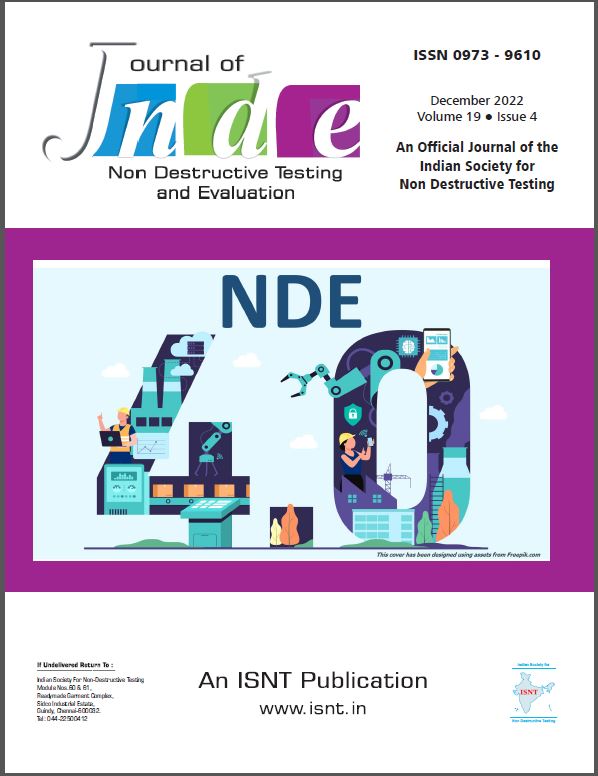
Published 25-11-2022
Keywords
- AI,
- NDE 4.0
How to Cite
Copyright (c) 2022 Journal of Non-Destructive Testing and Evaluation (JNDE)

This work is licensed under a Creative Commons Attribution-NonCommercial-NoDerivatives 4.0 International License.
Abstract
The use of machine learning in non-destructive evaluation (NDE) is a growing trend in the industry and a necessary development towards NDE 4.0. Beside academia, there are numerous case examples where machine learning is in use for actual inspections already. The main benefit of machine learning powered NDE is its reliability and repeatability to find flaws from the data. However, as the fundamental is in image recognition, machine learning can facilitate the inspection in general beyond just finding defects. These can be recognising the welds, image quality indicators and other features which the inspectors usually have to identify by themselves. In addition to reliability increase, automating these repeatable tasks increase the speed of data analysis considerably, saving inspector’s time where it is most valuable. In this paper we review use cases where machine learning has been used in NDE and how these approaches benefit the end customer.
References
- Nauman Munir, Hak-Joon Kim, Sung-Jin Song, and Sung-Sik Kang. Investigation of deep neural network with drop out for ultrasonic flaw classification in weldments. Journal of Mechanical Science and Technology, 32(7):3073–3080, 2018.
- N Munir, HJ Kim, J Park, SJ Song, and SS Kang. Convolutional neural network for ultrasonic weldment flaw classification in noisy conditions. Ultrasonics, 2018.
- Oskar Siljama, Tuomas Koskinen, Oskari Jessen-Juhler, and Iikka Virkkunen. Automated flaw detection in multi-channel phased array ultrasonic data using machine learning. Journal of Nondestructive Evaluation, 40(67), 2021.
- Tuomas Koskinen, Iikka Virkkunen, Oskar Siljama, Oskari Jessen-Juhler, and Jari Rinta-Aho. The effect of different flaw data to machine learning powered ultrasonic inspection. Journal of Nondestructive Evaluation, 40(24), 2021.
- Topias Tyystj¨arvi, Iikka Virkkunen, Peter Fridolf, Anders Rosell, and Zuheir Barsoum. Automated defect detection in digital radiography of aerospace welds using deep learning. Welding in the World, 66, 2022.
- Olaf Ronneberger, Philipp Fischer, and Thomas Brox. U-net: Convolutional networks for biomedical image segmentation, 2015.
- Luka Posilovi´c, Duje Medak, Fran Milkovi´c, Marko Subaˇsi´c, Marko Budimir, and Sven Lonˇcari´c. Deep learning-based anomaly detection from ultrasonic images. Ultrasonics, 124:106737, 2022.
- Dimitris Perdios, Adrien Besson, Marcel Arditi, and Jean-Philippe Thiran. A deep learning approach to ultrasound image recovery. In 2017 IEEE International Ultrasonics Symposium (IUS), pages 1–4, 2017.
- Bo Li, Kele Xu, Dawei Feng, Haibo Mi, Huaimin Wang, and Jian Zhu. Denoising convolutional autoencoder based b-mode ultrasound tongue image feature extraction. In ICASSP 2019 - 2019 IEEE International Conference on Acoustics, Speech and Signal Processing (ICASSP), pages 7130–7134, 2019.
- Fei Gao, Bing Li, Lei Chen, Xiang Wei, Zhongyu Shang, and Chen He. Ultrasonic signal denoising based on autoencoder. Review of Scientific Instruments, 91(4):045104, 2020.
- Nauman Munir, Jinhyun Park, Hak-Joon Kim, Sung-Jin Song, and SungSik Kang. Performance enhancement of convolutional neural network for ultrasonic flaw classification by adopting autoencoder. NDT E International, 111:102218, 2020.
- Sergio Cantero-Chinchilla, Paul D. Wilcox, and Anthony J. Croxford. A deep learning based methodology for artefact identification and suppression with application to ultrasonic images. NDT & E International, 126:102575, 2022.
- Johannes Vrana, Norbert Meyendorf, Nathan Ida, and Ripudaman (Ripi) Singh. Introduction to NDE 4.0, pages 1–28. Springer International Publishing, Cham, 2021.
- Marija Bertovic and Iikka Virkkunen. NDE 4.0: New Paradigm for the NDE Inspection Personnel, pages 239–269. Springer International Publishing, Cham, 2022.
- Karen Simonyan and Andrew Zisserman. Very deep convolutional networks for large-scale image recognition, 2014.
- Charles Annis. Mil-hdbk-1823a, nondestructive evaluation system reliability assessment. Technical report, 2009.
